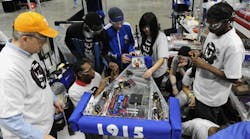The National Fluid Power Association (NFPA, www.NFPA.org) recently started a strategic alliance with FIRST, which stands for For Inspiration and Recognition of Science and Technology. FIRST is an international not-for-profit organization that is aimed at increasing interest and participation in science and technology among K-12 students.
The partnership will promote FIRST programs to NFPA’s membership and education partners, encouraging them to become FIRST mentors, coaches, and volunteers. It is expected to extend the reach of NFPA’s fluid power educational and career-building efforts so that they will be inclusive for FIRST students. NFPA is also offering a $40,000 merit-based scholarship to a high school senior participating on a 2017 FIRST Robotics Competition team. The scholarship is to be used to study engineering at any accredited technical school or university in the United States.
“NFPA is excited to be a Strategic Alliance partner of FIRST as our members are very supportive of the FIRST mission as Mentors and competition Suppliers. We look to grow that participation and also make more students aware of the outstanding careers available in fluid power through the NFPA Robotics Challenge FIRST Scholarship,” says Eric Lanke, President and CEO of NFPA.
“At FIRST, we work to broaden student exposure to a wide range of opportunities in STEM through our mentors, coaches, and volunteers,” says FIRST President Donald E. Bossi. “As a Strategic Alliance, NFPA will help give more FIRST students the opportunity to work side-by-side with professional engineers in the fluid power industry, while the generous NFPA Robotics Challenge FIRST Scholarship adds to the exclusive scholarship opportunities available for high school students who participate in FIRST.”
For more information about the alliance, or how your company can get involved in developing the future engineering workforce, contact Lynn Beyer, NFPA’s Director of Workforce Development Programs, at [email protected].



